This post may contain affiliate links. Please read our disclosure policy.
Colomba is absolutely a delicious Italian rich and sweet Easter bread that has a texture like a cake. The recipe is made with a biga preferment and the bread has nice fluffy crumbs that you will truly enjoy!

If you haven’t tried Colomba before, I strongly encourage you to do so. It is a bread that tastes like cake if you ask me. It is so soft and airy, yet sturdy like bread.
What is colomba pasquale
Colomba Pasquale is an Italian Easter cake that is shaped like a dove, which is a symbol of peace. It is similar to the traditional Italian Christmas cake, Panettone, but is flavored with orange zest and often contains candied peel and almonds.
Traditional Colomba vs this recipe
Traditional Colomba is made with a sourdough stiff starter known as lievito madre, the same one used to make traditional panettone. I don’t have lievito madre and honestly, I couldn’t be bothered to make one. I don’t think I’m at that level yet when it comes to sourdough enriched bread! This recipe used biga preferment to add that depth of flavor and the bread stays soft for days too. I highly recommend this recipe that I adapted from King Arthur Baking.

Use a high-quality strong instant yeast
I used to bake with active dry yeast until I baked panettone a few years ago and I swear by this SAF Gold instant yeast for the enriched dough. It’s a game-changer. This yeast is strong and made for dough that has high sugar and high fat. It gives the loaf a high rise, airy, and works quickly.
How to make Colomba pasquale using biga
1. Place all ingredients for biga in a mixing bowl. Stir with a spoon. Cover and put at room temperature and let it ferment for 10-15 hours. It will double or triple in size. The longer it takes to ferment, the better the flavor and that’s why we want it to ferment at room temperature or even do a cold ferment (in the fridge). 
2. Put all ingredients and biga, except for butter, in a mixing bowl of a stand mixer fitted with a dough hook attachment. Start mixing on low speed (speed 2 on KA) until you get a rough dough, and then increase speed to 4 and knead for about 5 minutes. This is a very sticky dough. You may need to stop the mixer and scrape the side of the bowl every 2-3 minutes.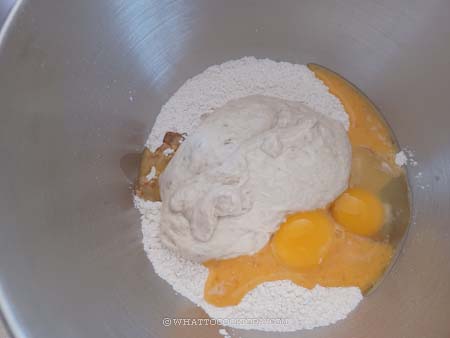
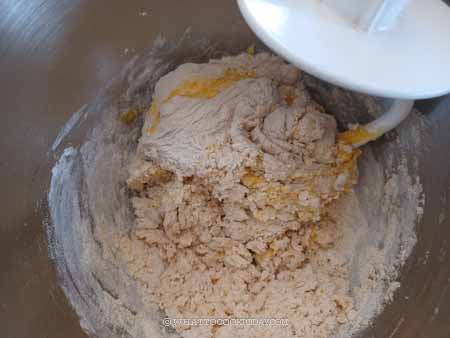
3. Then add the softened butter, pat by pat, and continue to knead on speed 4 until the dough absorbs all the butter, about 8-10 minutes of kneading with a stand mixer. The dough will be soft and shiny, clear the side of the bowl, but not entirely clean. The dough is still sticky to the bottom of the bowl. 
4. Add the orange zest and chopped dried fruit and just knead on the lowest speed only to combine everything. It may not fully combined, but don’t worry, it will distribute more evenly when we shape the dough. Careful not to over kneading the dough or the gluten may break and turn into a sticky mess.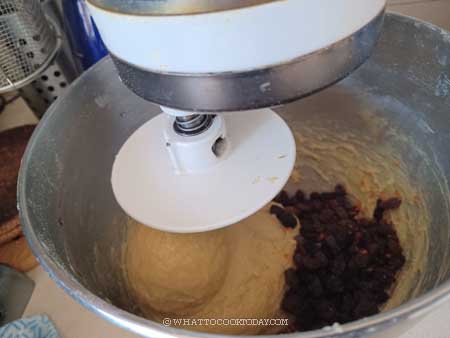

5. Oil the side of the bowl and use a dough scraper to scrape the dough and transfer to a large oiled-bucket to monitor fermentation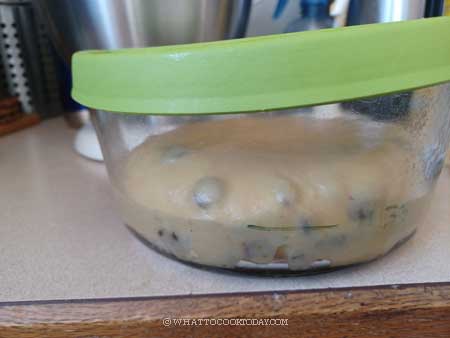
6. Let the dough ferment at a warm place until it doubles in size. It took me about 45 minutes using SAF Gold instant yeast. I made it before with active dry yeast and it took about 2-3 hours for the dough to rise near double.

7. Line a large baking sheet with parchment paper. Without deflating the dough yet, divide the dough into two pieces. Then gently flatten the dough slightly and shape it into about 10-inch log and the other about 7-inch log.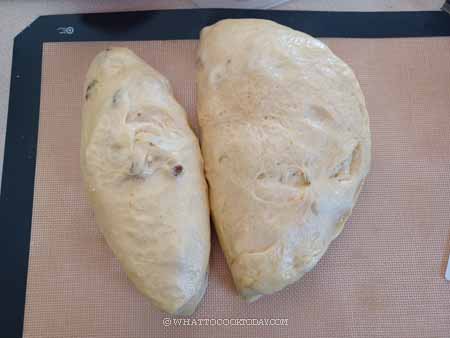
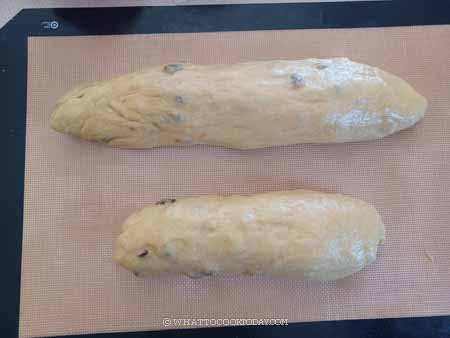
8. Line the long log crosswise on the parchment paper. Use the side of your hand to create a crease in the center of the dough. 
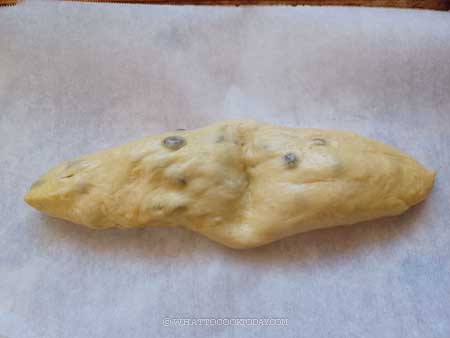
9. Lay the short log crosswise on the crease you just created. Shape this short log into a wing by gently shaping the two ends into a crescent-like shape
10. Use a scissor to cut the tip of the wings and the tail to make them look like “feathers”
12. Cover with plastic wrap that has been lightly oiled to prevent sticking. Let the dough rise again at a warm place until about 50% puffy, this may take 45 minutes to 1 hour with SAF Gold instant yeast. It took about 40 minutes for me. If you use regular yeast this may take 2 hours or so. You don’t want the dough to puff up too much that it loses the shape, but it should be about 50% puffy and when you gently push on the dough, it bounces back very slowly and leave an indentation
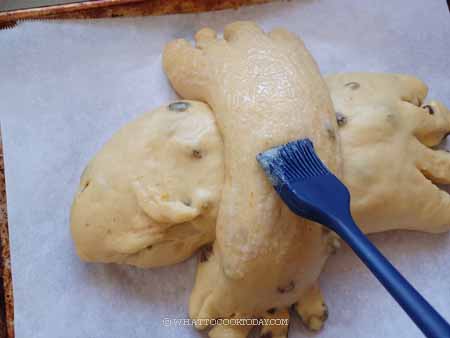
13. 10 minutes before the end of the final proofing, preheat the oven to 375 F (190C) for conventional oven, 350 F (180 C) for convection oven. Brush the dough with the egg white paste all over the surface. Arrange almond slices on top and add the coarse sugar. Use a whole almond for the eye (which I forgot LOL)

14. Bake for 15 minutes on the middle rack and then cover with an aluminum foil and lower temperature to 350 F and bake for another 10 minutes or until the temperature is 190 F at the center of the dough. Slide the Colomba onto a cooling rack to let it cool completely before serving
15. Slice into thin slices and enjoy it as is with a cup of tea or coffee. You can also toast it to accompany your Easter lunch or dinner

Did you make this Colomba pasquale using biga recipe?
I love it when you guys snap a photo and tag it to show me what you’ve made. Simply tag me @WhatToCookToday #WhatToCookToday on Instagram and I’ll be sure to stop by and take a peek for real!

How to store Colomb pasquale
1. Let the bread cool down completely. Store them in a bread box or in a large bread bag, push all the air out and seal the bag. They can be kept at room temperature for 2-3 days. The crumb remains soft for few days
2. For longer storage, keep them in a freezer bag, push all the air out and seal. Simply thaw at room temperature and slice to serve. They can be served as is or toasted
This recipe is adapted from King Arthur’s Baking with some modifications. It’s a keeper for me.
Italian Easter Dove Bread (Colomba Pasquale) – with Biga
Ingredients
Biga:
- 100 g bread flour (12% protein content)
- 90 g water
- ⅒ tsp instant yeast
Dough:
- 260 g bread flour (12% protein content)
- 10 g SAF Gold instant yeast
- 56 g sugar
- 7 g salt
- 110 g eggs from 2 large eggs
- 18 g egg yolk one egg yolk from a large egg
- 2 tsp vanilla extract
- ⅛ tsp orange oil
- 45 g unsalted butter
To add last:
- 140 g dried fruit cut into small pieces
- Zest of one orange
Topping:
- 1 egg white
- 3 Tbsp almond flour
- 30 g sugar
- 15 g sliced almond
- Turbinado sugar for sprinkling
Instructions
Prepare biga:
- Place all ingredients for biga in a mixing bowl. Stir with a spoon. Cover and put at room temperature and let it ferment for 10-15 hours. It will double or triple in size. The longer it takes to ferment, the better the flavor and that's why we want it to ferment at room temperature or even do a cold ferment (in the fridge). It can stay in the fridge for about 4-5 days before you use it and can be kept in the freezer for 3 months
- If you do a cold ferment, take it out from the fridge to let it comes to room temperature while you prepare other things
Prepare the dough:
- Put all ingredients and biga, except for butter, in a mixing bowl of a stand mixer fitted with a dough hook attachment. Start mixing on low speed (speed 2 on KA) until you get a rough dough, and then increase speed to 4 and knead for about 5 minutes. This is a very sticky dough. You may need to stop the mixer and scrape the side of the bowl every 2-3 minutes.
- Then add the softened butter, pat by pat, and continue to knead on speed 4 until the dough absorbs all the butter, about 8-10 minutes of kneading with a stand mixer. The dough will be soft and shiny, clear the side of the bowl, but not entirely clean. The dough is still sticky to the bottom of the bowl. Add the orange zest and chopped dried fruit and just knead on the lowest speed only to combine everything. It may not fully combined, but don't worry, it will distribute more evenly when we shape the dough. Careful not to over kneading the dough or the gluten may break and turn into a sticky mess.
First proofing:
- Oil the side of the bowl and use a dough scraper to scrape the dough and transfer to a large oiled-bucket to monitor fermentation
- Let the dough ferment at a warm place until it doubles in size. It took me about 45 minutes using SAF Gold instant yeast. I made it before with active dry yeast and it took about 2-3 hours for the dough to rise near double.
Shaping:
- Line a large baking sheet with parchment paper. Without deflating the dough yet, divide the dough into two pieces. Then gently flatten the dough slightly and shape it into about 10-inch log and the other about 7-inch log.
- Line the long log crosswise on the parchment paper. Use the side of your hand to create a crease in the center of the dough. Lay the short log crosswise on the crease you just created. Shape this short log into a wing by gently shaping the two ends into a crescent-like shape
- Use a scissor to cut the tip of the wings and the tail to make them look like "feathers"
Final proofing:
- Cover with plastic wrap that has been lightly oiled to prevent sticking. Let the dough rise again at a warm place until about 50% puffy, this may take 45 minutes to 1 hour with SAF Gold instant yeast. It took about 40 minutes for me. If you use regular yeast this may take 2 hours or so. You don't want the dough to puff up too much that it loses the shape, but it should be about 50% puffy and when you gently push on the dough, it bounces back very slowly and leave an indentation
Prepare the topping:
- Combine the egg white, sugar, and almond flour to make a sticky paste and set aside
Baking:
- 10 minutes before the end of the final proofing, preheat the oven to 375 F (190C) for conventional oven, 350 F (180 C) for convection oven
- Brush the dough with the egg white paste all over the surface. Arrange almond slices on top and add the coarse sugar. Use a whole almond for the eye (which I forgot LOL)
- Bake for 15 minutes on the middle rack and then cover with an aluminum foil and lower temperature to 350 F and bake for another 10 minutes or until the temperature is 190 F at the center of the dough
Cooling:
- Slide the Colomba onto a cooling rack to let it cool completely before serving
Serving:
- Slice into thin slices and enjoy it as is with a cup of tea or coffee. You can also toast it to accompany your Easter lunch or dinner


